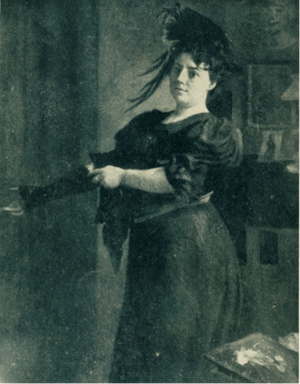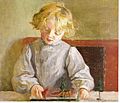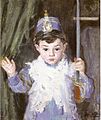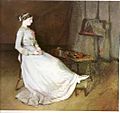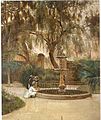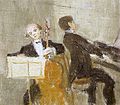Lluïsa Vidal facts for kids
Quick facts for kids
Lluïsa Vidal
|
|
|---|---|
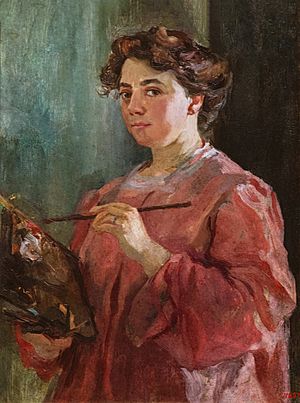
Self-portrait from 1899
|
|
| Born | 2 April 1876 |
| Died | 22 October 1918 (aged 42) |
| Nationality | Spanish |
| Known for | Painting |
| Movement | Catalan modernism |
Lluïsa Vidal i Puig (born in Barcelona on April 2, 1876, and died there on October 22, 1918) was a talented painter. She grew up in a wealthy family that was connected to the Catalan Modernism art movement. Lluïsa is famous for being the only professional female painter of Catalan Modernism. She was also one of the few women artists of her time who traveled to other countries to study art.
Contents
Lluïsa Vidal's Early Life and Art Training
Lluïsa Vidal was born in Barcelona. She was the second of 12 children in her family. Her father, Francesc Vidal i Jevellí, was a cabinetmaker and set designer. He loved art and business, and he encouraged Lluïsa's artistic talents.
Lluïsa learned to paint from her father first. She also studied with other artists like Joan González and Arcadi Mas i Fondevila. Later, when she was in Paris, she took lessons from Eugène Carrière. She was also inspired by famous painters like Santiago Rusiñol and Ramon Casas i Carbó.
When Lluïsa was 16, she visited Madrid with her father. She went to the Museo del Prado for the first time. There, she saw amazing paintings by Spanish masters like Francisco de Goya and Diego Velázquez. This trip helped her understand how valuable a good portrait painter could be.
Starting Her Professional Art Career
Lluïsa Vidal began her professional art career in 1898 when she was 22. She had her first art show at Quatre Gats in Barcelona. This made her the first and only woman to have an exhibition there.
In April 1898, she showed three portraits at a big art exhibition in Barcelona. More than 2,000 artworks were on display, including pieces by famous artists like Ramon Casas i Carbó and Santiago Rusiñol. Lluïsa received an honorable mention for one of her portraits. A newspaper called La Vanguardia said she was one of the best artists in the show. They even said her portrait of a girl was so good that male painters would be jealous!
In November 1898, she had another exhibition at Sala Parés. Her father and her teacher, Arcadi Mas i Fondevila, helped her with this show.
Studying Art in Paris
In 1901, Lluïsa Vidal moved to Paris to continue her art studies. She first learned from Henri-Léopold Lévy. Soon after, she joined Académie Julian, which had a special section for women artists. This section was led by Amélie Beaury-Saurel, who was also from Barcelona.
Lluïsa left the academy because she was not happy with it. After a short trip to England in 1902, she attended classes with Georges Picard and Eugène Carrière.
While in Paris, Lluïsa learned about the feminist movement. She also read La Fronde, a newspaper written only by women. She visited many museums and attended talks. This time in Paris helped her become more independent and confident in her art. She returned to Barcelona in 1902 because some of her sisters were sick, and her family was having money problems.
Returning to Barcelona and Her Art Academy
When Lluïsa came back to Barcelona, she brought many finished artworks and a strong feminist mindset. She met other important women like Carmen Karr and Dolors Monserdà. She started getting ready for more art shows.
The magazine Pèl & Ploma published some of her artworks. She also had another exhibition at Sala Parés. Even though her family life was difficult, her art career was at its best. She became an illustrator for Feminal magazine and held many exhibitions in Madrid and Barcelona.
To earn more money for her family, Lluïsa began giving private painting lessons in 1908. In 1911, she opened her own art academy in the old studio of artist Isidre Nonell.
Lluïsa also became very involved in social causes. During the Tragic Week in 1909, she joined the Women's Popular Library and the Culture Institute. This project helped single, working-class women get an education. She also became a peace activist during World War I, joining the Feminist Pacifist Committee.
In 1914, she had a very successful exhibition at Sala Parés. Barcelona newspapers called her a "distinguished woman" and a "celebrated artist."
Lluïsa Vidal sadly died in 1918 from the Spanish flu. She left all her belongings to her single sisters in her will.
Lluïsa Vidal's Artistic Style
Lluïsa Vidal is known as a Catalan modernism painter. This means her art used themes, colors, and light that were popular in that movement. She is considered part of the second generation of Catalan Modernism artists.
Some of her paintings were even thought to be by Ramon Casas i Carbó because their styles were similar. Both artists were influenced by masters like Diego Velázquez, John Singer Sargent, and Édouard Manet.
Portraits
Genre Scenes
-
Pablo Casals and Enric Granados, c. 1911.1914
-
Enric Granados's concert, c. 1911 – 1912
Drawings
-
Dolors Monserdà, Feminal, 1914
-
Margarida Xirgu. Feminal, 1914
See also
 In Spanish: Lluïsa Vidal para niños
In Spanish: Lluïsa Vidal para niños


